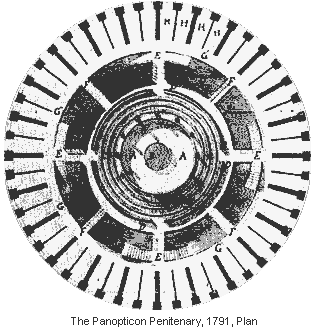  |
|
In 1785, the british philosopher Jeremy Bentham (1748-1832) founder of the doctrine of Utilitarianism, began working on a plan for a model prison called the panopticon: while this project obsessed him for nearly twenty years, it was in the end never built. Yet, in an ironic exemplification of Bentham’s own theory of fictions which holds that non-existent entities can nevertheless have very real effects, there has probably never been any other unbuilt structure that has provoked more theoretical debate. Reintroduced into contemporary philosophical discussion in 1975 by the french philosopher Michel Foucault’s analysis of its role as a model for the construction of power in what he calls a “disciplinary society”, the controlled space of the panopticon – in which the fact of actual observation is repaced by the possibility of being watched, with the very intriguing result that the prisoners internalize the disciplinary gaze and thus power operates by means of the spatial design itself — has since become synonymous with the cultures and practices of surveillance that have so profoundly marked the modern world.
[Thomas Y. Levin, Watching Watching: Tracking Surveillance in German Media Culture] |
The directionality, making of the prisoners a ‘multitude though not a crowd’ from the point of view of the governor, but ‘solitary and sequestered individuals’ from their own point of view, was the most important characteristic of the Panopticon’s hierarchical configuration. There are buildings whose plan looks very much like that of Panopticons. Usually the affinity is formal, not operational. Bentham always compared his penitentiary to the Ranelagh Pleasure Dome in Vauxhall Gardens. Except for its conscious irony, it does not seem an appropriate comparison. Ranelagh looked similar but it did not work inthe same fashion. Most circular buildings where, like chapels and theatres, distributed in such a way that one central event could be observed by many people. However, there had been two earlier types of building in which this principle was inverted, turning the stage into an observatory. Giulio Camillo’s mysterious Memory Theatre, as described by Frances Yates, performed a quite different function to the Panopticon in a similar way. A semi-circle of seven rising ranks of images were disported round a stage. Standing on this stage someone instructed in the meaning of the icons would find displayed before him ‘all that the mind could conceive and all that was hidden in the soul’. Like Panopticon it was a divulger of secrets. There was also a tradition going back to Lucullus of aviaries in which the observer, instead of being placed outside the cages, was placed in the centre looking outwards. Louis Le Vau adapted the idea in his Versailles Menagerie for Louis XIV, and others followed. In all these buildings the privileged eye determined the shape of the world.
[Robin Evans, The fabrication of virtue, English prison architecture 1750-1840, 1982] |